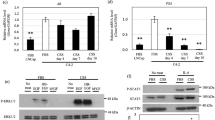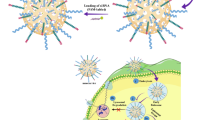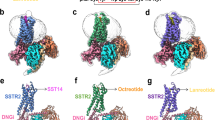Abstract
Aim:
Somatostatin receptor subtype 2 (SSTR2) is the principal mediator of somatostatin's (SST) antiproliferative effects on normal and cancer cells. Therefore, we investigated whether the enhanced expression of SSTR2 could inhibit the proliferation of tumor cells, and, if so, the mechanisms that might be involved.
Methods:
SSTR2 expression levels were determined by qRT-PCR in several tumor cell lines. Then, a plasmid pIRES2-EGFP-SSTR2 (pSIG) was constructed and stably transfected into MCF-7 cells (MCF-7/pSIG). After SSTR2 overexpression was identified by qRT-PCR, immunofluorescence staining and a receptor binding assay, the MCF-7/pSIG cells were analyzed by PI staining for apoptosis and cell cycle arrest was tested by flow cytometry for epidermal growth factor receptor (EGFR) expression. The EGF-stimulated proliferation of MCF-7 cells was assayed by MTT.
Results:
The human breast cancer cell line MCF-7 expresses a lower level of SSTR2, thereby partly accounting for the decreased response to SST. The overexpression of SSTR2 in MCF-7 cells resulted in apoptosis, cytostasis and G1/S cell cycle arrest. Furthermore, the expression of EGFR, together with EGF-stimulated proliferation, was markedly decreased in the MCF-7/pSIG cells.
Conclusion:
Enhanced SSTR2 expression played an antiproliferative role in MCF-7 cells through inducing apoptosis and G1/S cell cycle arrest, and also by decreasing EGFR expression, thereby counteracting the growth-stimulating effect of EGF. Our data seem to indicate that developing a new therapeutic agent capable of upregulating SSTR expression could potentially be a way to block tumor progression.
Similar content being viewed by others
Log in or create a free account to read this content
Gain free access to this article, as well as selected content from this journal and more on nature.com
or
References
Watt HL, Kharmate G, Kumar U . Biology of somatostatin in breast cancer. Mol Cell Endocrinol 2008; 286: 251–61.
Patel YC, Srikant CB . Somatostatin receptors. Trends Endocrinol Metab 1997; 8: 398–405.
Buscail L, Estève JP, Saint-Laurent N, Bertrand V, Reisine T, O'Carroll AM, et al. Inhibition of cell proliferation by the somatostatin analogue RC-160 is mediated by somatostatin receptor subtypes SSTR2 and SSTR5 through different mechanisms. Proc Natl Acad Sci USA 1995; 92: 1580–4.
Kumar U, Grigorakis SI, Watt HL, Sasi R, Snell L, Watson P, et al. Somatostatin receptors in primary human breast cancer: quantitative analysis of mRNA for subtypes 1–5 and correlation with receptor protein expression and tumor pathology. Breast Cancer Res Treat 2005; 92: 175–86.
Schulz S, Helmholz T, Schmitt J, Franke K, Otto HJ, Weise W . True positive somatostatin receptor scintigraphy in primary breast cancer correlates with expression of sst2A and sst5. Breast Cancer Res Treat 2002; 72: 221–6.
Cameron Smith M, Orlando C, Serio M, Maggi M . Somatostatin receptors and breast cancer. J Endocrinol Invest 2003; 26: 125–30
Van Den Bossche B, Van Belle S, De Winter F, Signore A, van de Wiele C . Early prediction of endocrine therapy effect in advanced breast cancer patients using 99mTc-depreotide scintigraphy. J Nucl Med 2006; 47: 6–13
Watt and Kumar . Colocalization of somatostatin receptors and epidermal growth factor receptors in breast cancer cells. Cancer Cell Int 2006; 6: 5
Reubi JC, Torhorst J . The relationship between somatostatin, epidermal growth factor, and steroid hormone receptors in breast cancer. Cancer 1989; 64: 1254–60.
Lacroix M, Leclercq G . Relevance of breast cancer cell lines as models for breast tumours: an update. Breast Cancer Res Treat 2004; 83: 249–89.
Wiseman SM, Makretsov N, Nielsen TO, Gilks B, Yorida E, Cheang M, et al. Coexpression of the type 1 growth factor receptor family members HER-1, HER-2, HER-3 has a synergistic negative prognostic effect on breast carcinoma survival. Cancer 2005; 103: 1770–7.
Pawlikowski M, Melen-Mucha G . Somatostatin analogs — from new molecules to new applications, Curr Opin Pharmacol 2004; 4: 608–13.
Susini C, Buscail L . Rationale for the use of somatostatin analogs as antitumor agents, Ann Oncol 2006; 17: 1733–42.
Abel F, Ejeskar K, Kogner P, Martinsson T . Gain of chromosome arm 17q is associated with unfavourable prognosis in neuroblastoma, but does not involve mutations in the somatostatin receptor 2 (SSTR2) gene at 17q24. Br J Cancer 1999; 81: 1402–9.
Sestini R, Orlando C, Peri A, Tricarico C, Pazzagli M, Serio M, et al. Quantitation of somatostatin receptor type 2 gene expression in neuroblastoma cell lines and primary tumors using competitive reverse transcription-polymerase chain reaction. Clin Cancer Res 1996; 2: 1757–65.
Van Den Bossche B, D′haeninck E, De Vos F, Dierckx RA, Van Belle S, et al. Oestrogen-mediated regulation of somatostatin receptor expression in human breast cancer cell lines assessed with 99mTc-depreotide. Eur J Nucl Med Mol Imaging 2004; 31: 1022–30.
De Felipe P . Polycistronic viral vectors. Curr Gene Ther 2002; 2: 355–78.
Ballian N, Brunicardi FC, Wang XP . Somatostatin and its receptors in the development of the endocrine pancreas. Pancreas 2006; 33: 1–12.
YC Patel . Somatostatin and its receptor family. Frontiers Neuroendocrinol 1999; 20: 157–98.
Krause DS, van Etten RA . Tyrosine kinases as targets for cancer therapy. N Engl J Med 2005; 353: 172–87.
Schally AV, Szepeshazi K, Nagy A, Comaru-Schally AM, Halmos G . New approaches to therapy of cancers of the stomach, colon and pancreas based on peptide analogs. Cell Mol Life Sci 2004; 61: 1042–68.
Acknowledgements
The project was supported by grants from the National Natural Science Foundation of China (No 30400112 and No 30270412) and Hubei Key Sci & Tech. R&D programme (No 2006AA301A05). We thank Zhi-hui LIANG for the flow cytometry assays. We thank Jing-fang SHAO, Yue ZHANG, Jing YANG, Wei FENG, Xiao-dan JIANG, Ping XIONG, and Yong XU for expert technical assistance.
Author information
Authors and Affiliations
Corresponding author
Rights and permissions
About this article
Cite this article
He, Y., Yuan, Xm., Lei, P. et al. The antiproliferative effects of somatostatin receptor subtype 2 in breast cancer cells. Acta Pharmacol Sin 30, 1053–1059 (2009). https://doi.org/10.1038/aps.2009.59
Received:
Accepted:
Published:
Issue date:
DOI: https://doi.org/10.1038/aps.2009.59
Keywords
This article is cited by
-
Distinctive detection of insulinoma using [18F]FB(ePEG12)12-exendin-4 PET/CT
Scientific Reports (2021)
-
Docetaxel in combination with octreotide shows synergistic apoptotic effect by increasing SSTR2 and SSTR5 expression levels in prostate and breast cancer cell lines
Cancer Chemotherapy and Pharmacology (2015)
-
Inhibition of tumor promoting signals by activation of SSTR2 and opioid receptors in human breast cancer cells
Cancer Cell International (2013)
-
The new truncated somatostatin receptor variant sst5TMD4 is associated to poor prognosis in breast cancer and increases malignancy in MCF-7 cells
Oncogene (2012)
-
Receptor activation and inhibition in cellular response to chemotherapeutic combinational mimicries: the concept of divergent targeting
Journal of Neuro-Oncology (2010)



